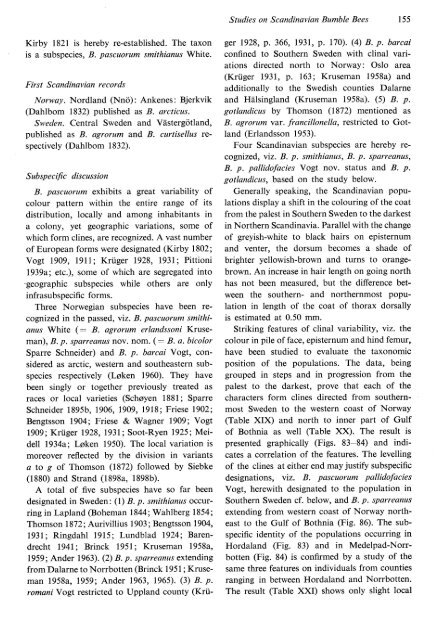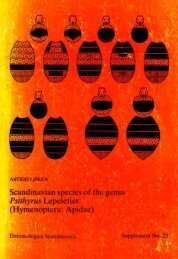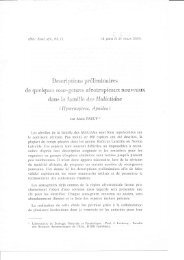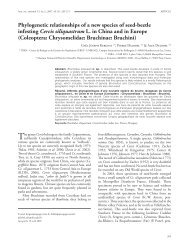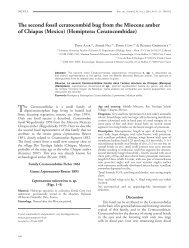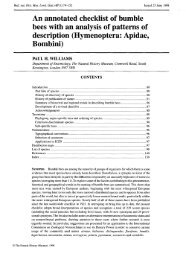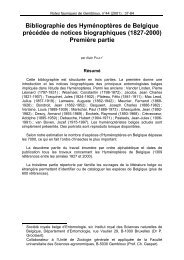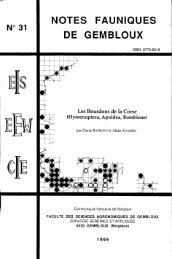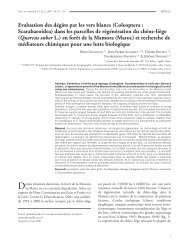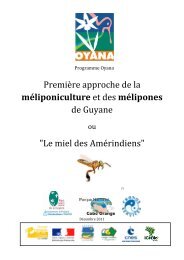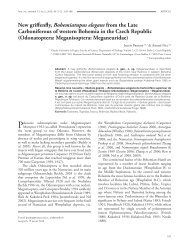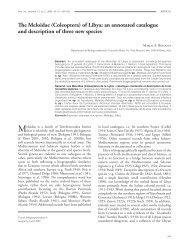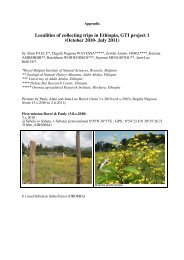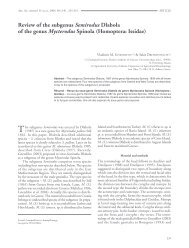Bumble Bees
Bumble Bees
Bumble Bees
You also want an ePaper? Increase the reach of your titles
YUMPU automatically turns print PDFs into web optimized ePapers that Google loves.
Studies on Scandinavian <strong>Bumble</strong> <strong>Bees</strong> 155Kirby l82l is hereby re-established. The taxonis a subspecies, B. pascuorum smithianus White.First Scandinavian recordsNorway. Nordland (Nno): Ankenes: Bjerkvik(Dahlbom 1832) published as B. arcticus.Sweden Central Sweden and Vdstergcitland,published as B. agrorum and B. curtisellus respectively(Dahlbom 1832).Subspectfic discussionB. poscuorum exhibits a great variability ofcolour pattern within the entire range of itsdistribution, locally and among inhabitants ina colony, yet geographic variations, some ofwhich form clines, are recognized. A vast numberof European forms were designated (Kirby 1802;Vogt 1909, lgll; Kri,iger 1928, l93l; Pittioni1939a; etc.), some of which are segregated into-geographic subspecies while others ate onlyinfrasubspecific forms.Three Norwegian subspecies have been recognizedin the passed, viz. B. pascuorum smithi'Anus White ( - B. agrorum erlandssoni Kruseman),B. p. sparreanus nov. nom. (: B. a. bicolorSparre Schneider) and B. p. barcai Vogt, consideredas arctic, western and southeastern subspeciesrespectively (Loken 1960). They havebeen singly or together previously treated asraces or local varieties (Schoyen 1881 ; SparreSchneider 1895b, 1906, 1909, 1918; Friese 1902;Bengtsson 1904; Friese & Wagner 1909 ; Vogt1909; Kriiger 1928, l93l; Soot-Ryen 1925; Meidell1934a; Laken 1950). The local variation ismoreover reflected by the division in variantso to g of Thomson (1872) followed by Siebke(1880) and Strand (1898a, 1898b).A total of five subspecies have so far beendesignated in Sweden: (1) B. p. smithianus occurringin Lapland (Boheman 1844; Wahlberg 1854;Thomson 1872; Aurivillius 1903; Bengtsson 1904,193 1 ; Ringdahl 1915 ; Lundblad 1924; Barendrechtl94l; Brinck 1951; Kruseman 1958a,1959; Ander 1963). (2) B. p. sparreanus extendingfrom Dalarne to Norrbotten (Brinck 1951; Kruseman1958a, 1959; Ander 1963, 1965). (3) B. p.romani Vogt restricted to Uppland county (Krii-ger 1928, p. 366, 1931, p. 170). @) B. p. barcaiconfined to Southern Sweden with clinal variationsdirected north to Norway: Oslo area(Krtiger 1931, p. 163; Kruseman 1958a) andadditionally to the Swedish counties Dalarneand Hiilsingland (Kruseman 1958a). (5) B. p.gotlandicus by Thomson (1872) mentioned asB. agrorum var. francillonella, restricted to Gotland(Erlandsson 1953).Four Scandinavian subspecies are hereby recognized,viz. B. p. smithianus, B. p. sparreanus,B. p. pallidofacies Vogt nov. status and B. p.gotlandicus, based on the study below.Generally speaking, the Scandinavian populationsdisplay a shift in the colouring of the coatfrom the palest in Southern Sweden to the darkestin Northern Scandinavia. Parallel with the changeof greyish-white to black hairs on episternumand venter, the dorsum becomes a shade ofbrighter yellowish-brown and turns to orangebrown.An increase in hair length on going northhas not been measured, but the difference betweenthe southern- and northernmost populationin length of the coat of thorax dorsallyis estimated at 0.50 mm.Striking features of clinal variability, viz. thecolour in pile of face, episternum and hind femur,have been studied to evaluate the taxonomicposition of the populations. The data, beinggrouped in steps and in progression from thepalest to the darkest, prove that each of thecharacters form clines directed from southernmostSweden to the western coast of Norway(Table XIX) and north to inner part of Gulfof Bothnia as well (Table XX). The result ispresented graphically (Figs. 83-84) and indicatesa correlation of the features. The levellingof the clines at either end may justify subspecificdesignations, yiz. B. pascuorum pallidofaciesVogt, herewith designated to the population inSouthern Sweden cf. below, and B. p. sparreanusextending from western coast of Norway northeastto the Gulf of Bothnia (Fig. 86). The subspecificidentity of the populations occurring inHordaland (Fig. 83) and in Medelpad-Norrbotten(Fig. 84) is confirmed by a study of thesame three features on individuals from countiesranging in between Hordaland and Norrbotten.The result (Table XXI) shows only slight local


